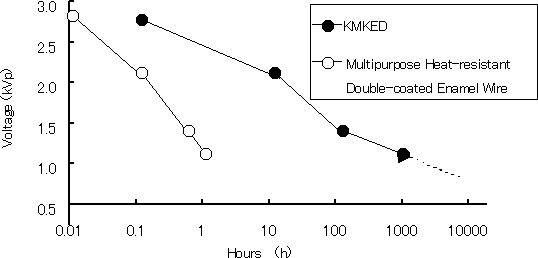2002 The former Hitachi Cable News Release
Information (including product prices, product specifications, details of services, launch dates, inquiry information, and URLs) contained in this news release is current as of the date of the press release but is subject to change without notice. Please note that details may differ from those effective on the search date.
Announcing the Release of Inverter Surge-resistant Enamel Wire
Hitachi Cable is pleased to announce the release of the KMKED Series of inverter surge-resistant enamel wire.
Recent years have seen a movement toward the wiser use of energy. Major electronic device manufacturers are rapidly adopting inverter systems to control and drive power supplies that are energy-efficient and offer variable speed control.
A pulse of power is released when an inverter is used to drive a motor. In recent years, many electrical devices have adopted new elements that allow for greater efficiency and noise reduction. As a result, the amount of power released as a pulse rises to excessive levels. In other words, an "inverter surge" results.
For example, manufacturing devices often use a 400V class inverter. The electrical output of this inverter is usually around 600Vp (750Vp when being used at maximum capacity). However, an "inverter surge" releases as much as twice the normal level of power, which results in a partial discharge. A partial discharge breaks down organic insulation material, such as enamel, exposing the coil insulation to serious damage. This can also shorten the life of an electrical device.
Manufacturers of electronic equipment have long been investigating ways to minimize the damage from these inverter surges. Hitachi Cable's inverter surge-resistant enamel wire reduces insulation degradation due to partial discharge, even when an inverter surge occurs, resulting in a longer life for the electrical device. This wire will make electrical devices even more trustworthy.
Technology used in the Development of this Product
It is well known that inorganic insulators, such as ceramic material, are useful for minimizing motor wire degradation caused by partial discharges. However, inorganic insulating materials have certain disadvantages when compared with organic insulating materials. For instance, inorganic material is less flexible and more prone to damage when a wire is wound onto a coil at a high speed. Because of this, there is considerable interest in compound insulation materials that combine the merits of both organic and inorganic materials.
However, the usual method for combining organic and inorganic materials, mixing organic varnish with inorganic powder, results in poor inorganic powder dispersal. Because of this, the stress created from winding a coil can cause electrical and mechanical defects. What is needed is a breakthrough technology.
Leveraging technology for controlling nanometer-sized particles cultivated through many years of enamel wiring development, Hitachi Cable has succeeded in evenly distributing nanometer-level silica particles within an enamel varnish. As a result, the Company has been able to develop a proprietary organic/inorganic nano-composite*1 that has the ability to resist partial discharges while still retaining flexibility and the strength to resist stress caused by coil winding. This composite is an optimal enamel insulating membrane.
As a result, this enamel wire has achieved a failure time of more than 1000 times (1.1kVp applied voltage) that of the Company's conventional heat-resistant double-coated enamel wire. In addition, the failure time of the actual motor has increased by more than 300 times (1.1kVp applied voltage) as compared with the Company's conventional heat-resistant double-coated enamel wire.
Hitachi Cable expects that this product will be used in highly efficient industrial inverter control motors, high voltage motors, and in hybrid electric vehicles (HEVs).
This enamel wire is a strategic part of the Company's global Magnet Wires business because it meets the worldwide demand for energy efficiency. Hitachi Cable is making every effort to expand its lineup of products that meet today's needs for energy efficiency.
Fiscal 2003 net sales of this product are expected to be 0.5 billion yen.
| *1 | Nano-composite: Nanometer level (1/1,000,000,000th of a meter) composite materials |
Failure time of the Inverter Surge-resistant Enamel Wire at voltage endurance test(10 kHz)
KMKED-20E
Multipurpose Heat-resistant Double-coated Enamel Wire
Corrosion of Enamel Wires Caused by Partial Discharge
(Photo: Cross-section of sample of twice-wound wire after an inverter surge test)
KMKED Series Lineup
| 1. | Heat-resistant Class: 200 degC.(AMW-XV, EIW-A) |
| 2. | Standard Size: 0.32-1.6 mm |
| 3. | Packaging: PT-60 (60kg coil) PT-270 (270kg coil) |
| * | The larger packing size makes for less wire replacement. |


